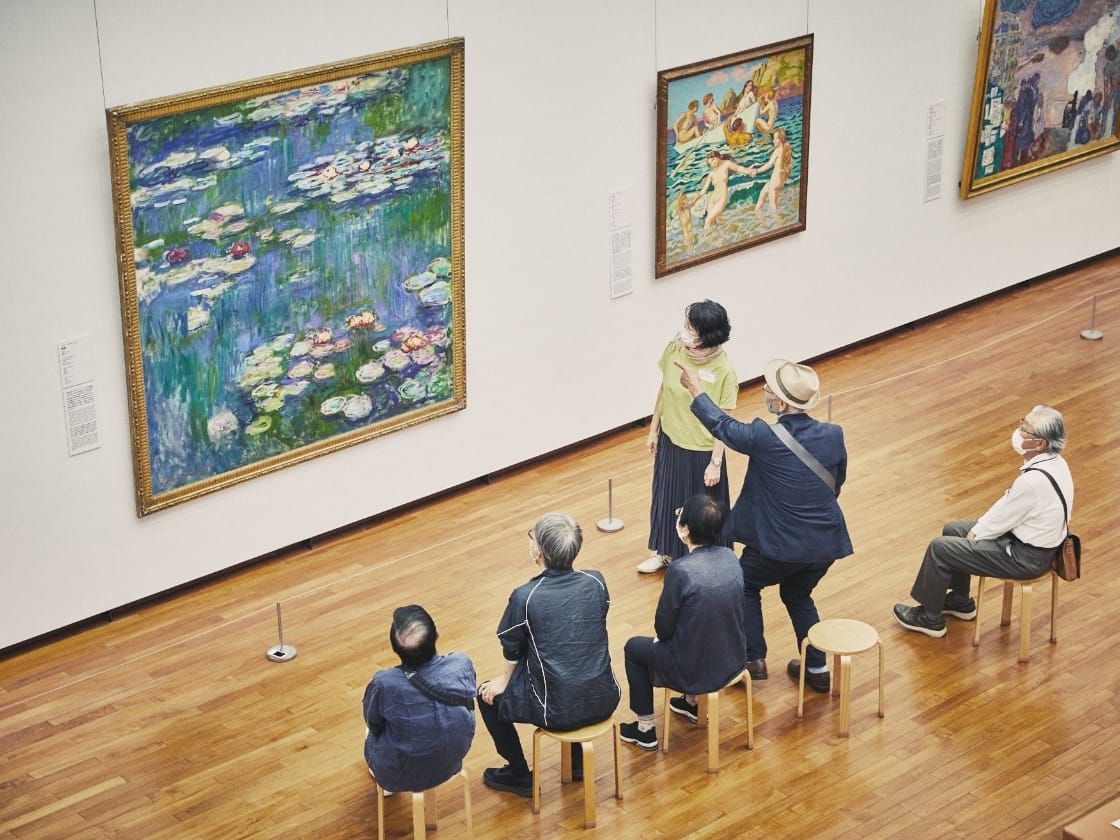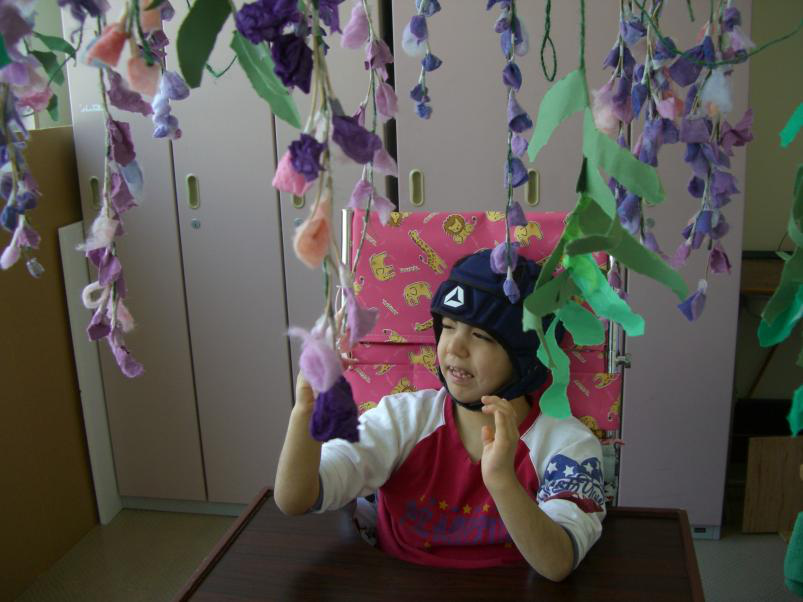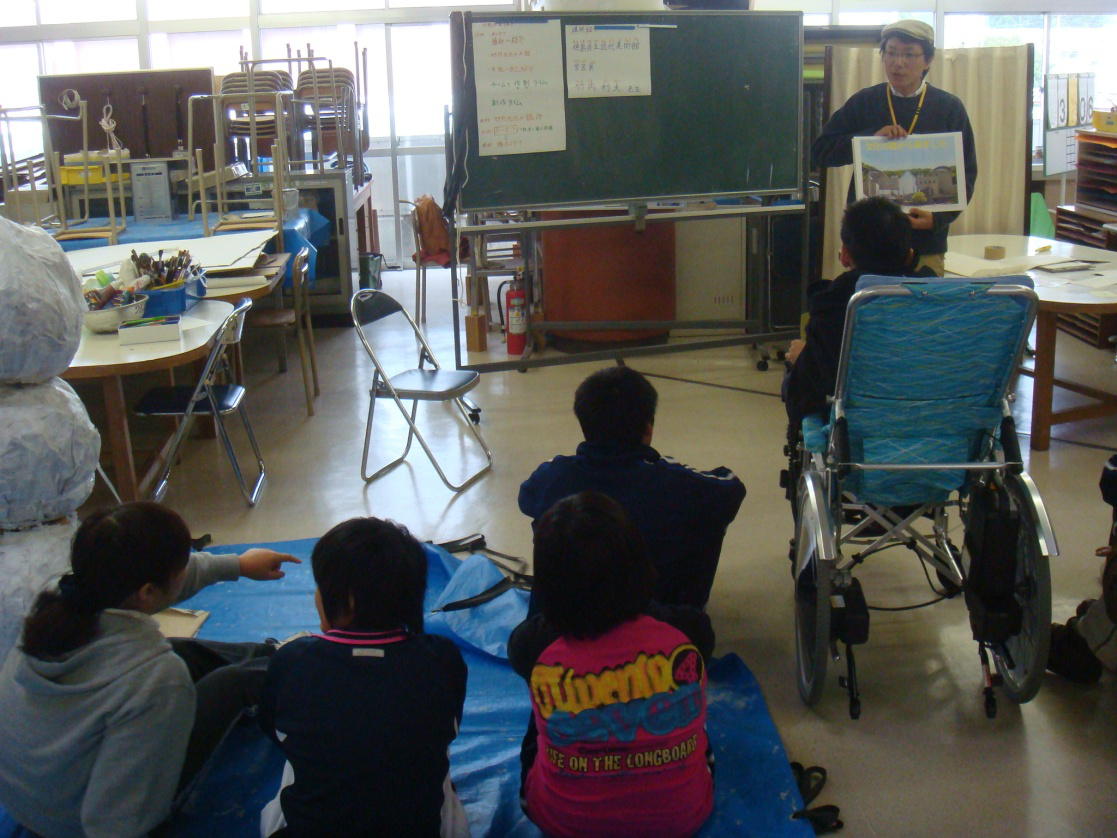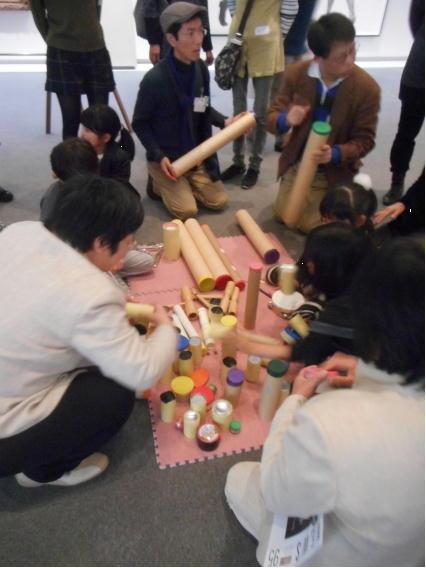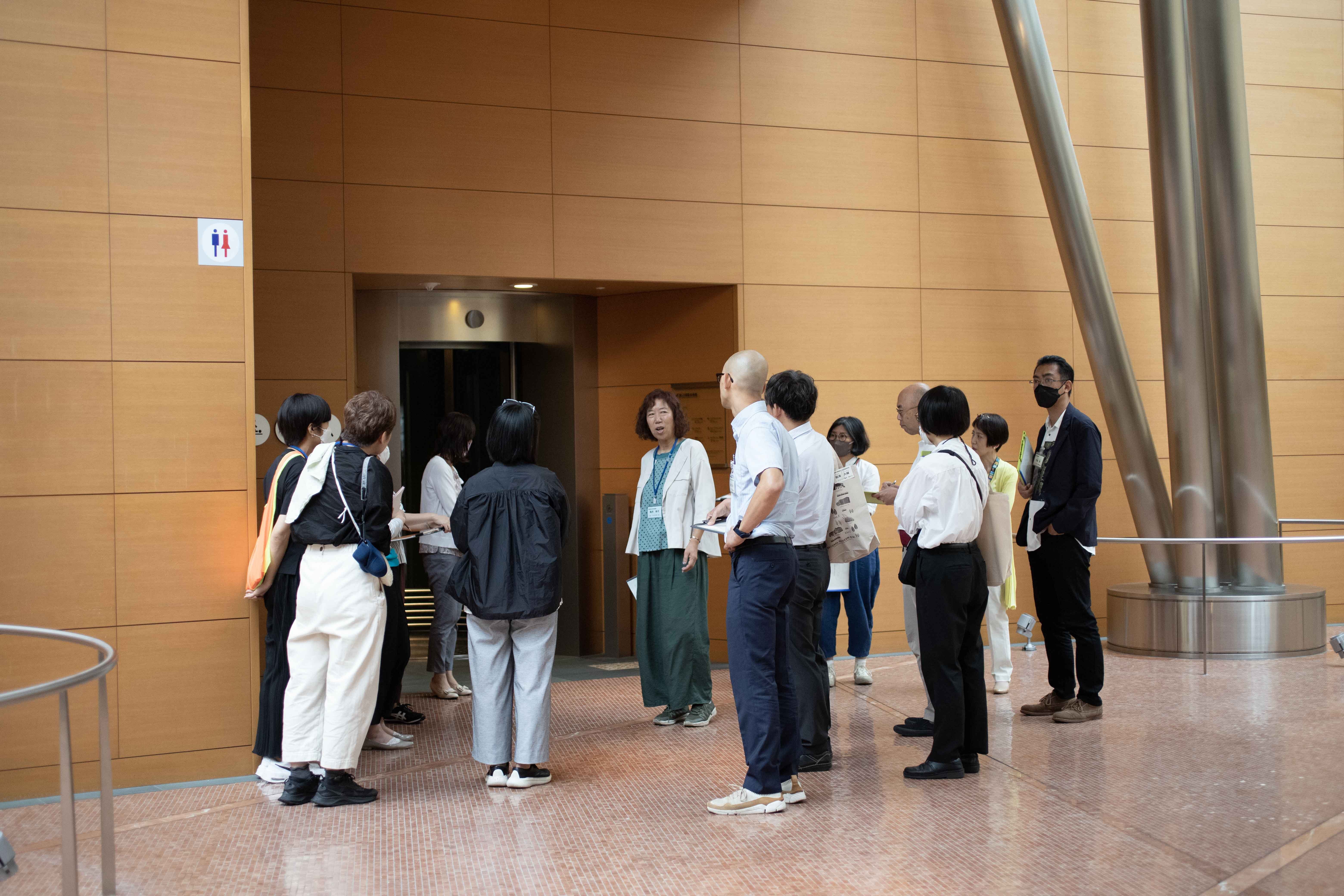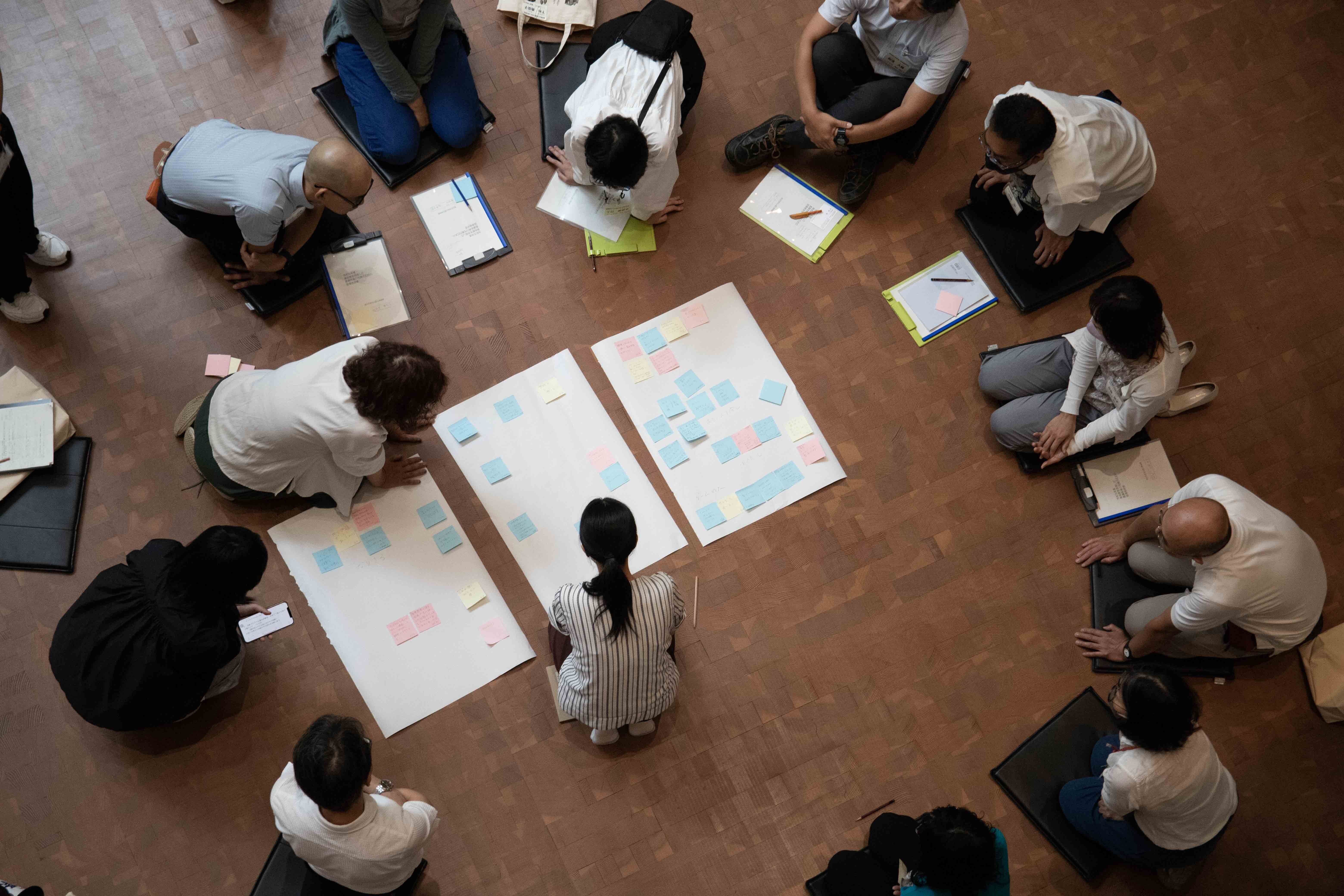Museums and Reasonable Accommodation: People with Severe/Multiple Disabilities Visiting Art Museums
Former Tokushima Modern Art Museum educator/
DEAI Research Lab. member
Kamei Sachiko
In August 2023, a research group called the DEAI Research Lab.* was launched as part of the National Center for Art Research’s accessibility project.
DEAI is an acronym comprising the first letters of the following four words: Diversity, Equity, Accessibility, and Inclusion. At the DEAI Research Lab., we research the global DEAI trends and investigate specific methods and requirements for improving museums’ accessibility. On the first year, four outside experts with relevant specialized knowledge joined us to conduct research on reasonable accommodation in museums. In this “DEAI Research Report” series, DEAI Research Lab. members present cases they have studied.
In this article, which forms the 2nd Research Report, former Tokushima Modern Art Museum educator Kamei Sachiko uses her experience in special needs schools to write about problems and challenges that museums face in meeting the needs of children with severe/multiple disabilities.
* For more information and explanation for “DEAI Research Lab.” or reasonable accommodation, please read the following article: Launch of the DEAI Research Lab. and Reasonable Accommodation.
** ‘Museum(s)’ as used in this article includes not only art museums but also museums of the humanities such as archaeology, history, folklore, and literature museums; natural science museums devoted to natural history and science and engineering; aquariums; zoological and botanical gardens; and archives and memorial museums.
Introduction
For many years, I worked as a high school art teacher at schools for the deaf (now special needs education schools for the deaf) and other special needs schools in Tokushima Prefecture. In 2011, I was transferred to work at Tokushima Modern Art Museum, where I worked for 12 years as a museum educator, endeavouring to coordinate with formal education and working on the Universal Museum Project. Since retiring in 2023, I have worked as a freelance educator, doing art activities with preschool-aged children and running inclusive workshops for people with all kinds of needs, with or without disabilities.
In this report, I will consider what should be done so that people with severe or multiple disabilities can safely and comfortably spend time in art museums, based on my experience leading senior high school special needs classes at special needs schools for children with severe intellectual disabilities in need of medical care and children with orthopaedically impaired multiple disabilities.
Taking Students with Severe/ Multiple Disabilities to Art Museums
A little over a decade ago, when the concept of “reasonable accommodation” did not yet exist, I wanted to take students with severe/multiple disabilities to visit an art museum. I contacted two museums within field-trip distance from the school, consulted with them and made the field trip happen. Here, I will introduce this case example in line with the process of “reasonable accommodation.” It is divided into three phases:
1. Details of the Problems/Demands of People with Disabilities and Supporters
2. Dialogue between Museums and People with Disabilities and Supporters
3. Content Ultimately Implemented through Mutual agreement
1. Problems/Demands
-With full-reclining wheelchairs that students with severe/multiple disabilities use (which can also be used as stretchers), it is difficult to move from one floor to another without a large elevator or gentle slopes. This ends up limiting their range of action.
-Because these are senior high school students, they need spaces in which their adult diapers can be changed, but even restrooms for people with disabilities are very rarely equipped with adult diapers changing stations, which limits the places they are able to visit.
▼
2. Dialogue
Of the two candidate art museums, one had only a small elevator for visitors. Concluding that it would be difficult for full-reclining wheelchairs to move around there, I decided not to consult with this museum about specific requests.
The other museum had a large elevator available to ordinary visitors, and full-reclining wheelchairs would be able to access any of the floors. Because I knew that there would be no impediments to moving about within the museum, I communicated with them about the need for spaces to change adult diapers and to have meals and breaks. I was able to consult with them about details such as how much space was needed, and what kinds of equipment would be necessary.
▼
3. Mutual Agreement
There were no restrooms for people with disabilities that were equipped with adult diaper-changing stations, and no dedicated break rooms, but they asked if it would be alright to use small spaces such as a multipurpose room or a lecturer waiting room, and we reached an agreement through alternative plans. After confirming dates on which these rooms could be used, we decided on a day for the field trip.
Furthermore, because the regular entrance only had an escalator and a normal elevator, I had them arrange for us to be able to enter the museum smoothly using the large elevator accessed through the underground parking lot entrance.
On the day of the field trip, even non-verbal students who have difficulty communicating showed signs of interest in their surroundings. The exhibition rooms had works in which the entire space, including the ceilings, was covered in artwork, and the students stared in curiosity. Students whose facial expressions could reveal signs of delight or discomfort seemed to pass the time in a state of relaxation. At the art museum, not only the artworks, but also the encounters with people, the atmosphere they could feel in the building, and sounds and smells provided various stimuli for the students. There is no doubt that they were able to savour different sensations than those of their everyday routine.
Being Transferred to Work in the Museum
The year after this field trip, I was transferred to work at the art museum that I had decided not to try to bring the students to. This was completely unexpected. I was notified of the transfer shortly after the death of a student in my charge from a progressive serious illness, and this time I would be on the museum side, aiming to receive people with disabilities in a way that would allow them to feel safe and comfortable.
However, while I was employed at the art museum, there were unfortunately no opportunities to welcome visitors with severe/multiple disabilities. One of the reasons was that, even more than a decade after I first contacted the museum, its facilities and equipment had not changed. However, if those working at the facility are unaware of the fact that there are wheelchair users that are not fully served by the existing elevator, there will be no reason for the current status to change. The thinking around “reasonable accommodation” needs to spread to people with disabilities and their family members and teachers, and rather than giving up on going to a place because they cannot use the elevator, I believe that they need to communicate their requests, stating that they would like to visit the museum but that they cannot use its elevator, or asking if the museum has a larger elevator available. Even if an elevator cannot be installed right away, these requests would allow the museum to encounter new visitors and spark a dialogue with them.
Another Barrier
However, if facilities were equipped with a completely barrier-free environment, would this really lead to more people with severe disabilities visiting art museums?
Due to worries that children with severe disabilities or intellectual disabilities would have a difficult time appreciating works of art in a museum, or that they would cause a nuisance by being loud or running around, there are many cases in which people give up on going to art museums in the first place. This is the same for nursery schools, certified child centres, and families with small children, in which teachers and guardians decide that art museums are too difficult and that children cannot enjoy them. I feel that this is another type of barrier.
In order to remove this barrier, I think we need to have guardians and teachers have more of their own fun experiences at art museums and give them a specific idea of what it would look like to see children active at art museums. It is also important to have them truly feel the importance of having opportunities to experience the arts and rich cultural activities as a part of a good life, even if one has severe disabilities.
Group Work for Special Needs Schools from the Teacher and Curator Training Program
The Teacher and Curator Training Program (see note) organized by the Independent Administrative Institution National Museum of Art was held in August 2023 at the National Museum of Art, Osaka. Last year was the 18th year of this program, and the first in which a group was set up focusing on special needs schools. As a facilitator, I participated in group work with special needs schoolteachers working at schools for the blind or with children and young people with severe disabilities, alongside curators from art museums across the country. To think about activity programs at exhibitions, we started by brainstorming while confirming the facilities and equipment needed at art museums to meet children’s diverse needs. Sharing our confusion about what to do in places with inconsistent Braille block usage and coming up with ideas to familiarize students with art appreciation according to the severity of their disabilities and their developmental stages, this program proved to be a valuable opportunity for interaction.
Teachers in charge of students with severe disabilities noticed that, with only one elevator, only one wheelchair could be moved at a time. They pointed out that, when bringing large groups of students in wheelchairs, it would take several elevator trips to move them. If it were going to take a lot of time to move from a museum’s first-floor entrance to the first underground level lobby, putting together a schedule that takes the necessary time into account and leaves a certain margin for gathering everyone at the planning stages would allow teachers to overcome the issue.
Furthermore, if teachers and curators started a dialogue to discuss how long the wait would be if 10 wheelchairs were to be moved, and thought together about what art-related games or quizzes they could have the students do while they wait, this could surely be an enriching time for the students.
Conclusion
Over 10 years ago, I abandoned the idea of doing a field trip because an elevator was too small, but now, if I were to approach an art museum about “reasonable accommodation” from my position as a teacher, I wonder how that would unfold.
The large elevators in art museums are for the intake of artwork. This would be an exceptional use of such elevators, but I think it would be possible to find a compromise for moving people with large service elevators. However, students are not cargo. This would be at most a temporary measure.
As with the above examples, if teachers and art museum staff could consult with each other while getting a better grasp on the activity content, it should be possible for a more positive mode of thought to lead to the creation of fun activities. For example, we could think of exhibition field trips as a type of activity program for “back-of-house tours with a museum curator.” Doubling up with a field trip to learn about the details of museum work, facilities, and equipment, it would be possible to use the service elevator as part of this objective. Students would also get to carefully appreciate the exhibitions. Utilizing existing equipment and incorporating more ideas may steadily expand the activities.
Before drafting ideas such as these, one might assume that children with severe/multiple disabilities would find it impossible to understand what a curator says. This is not the case. For children with few connections to society, it is a valuable experience to hear museum staff kindly call them by name and talk to them. Feeling the movement of an elevator, and just hearing footsteps walking down a long corridor or the voices of people talking, may be a comfortably stimulating experience for them.
If you have a strong desire to experience the fascinating activity of appreciating art at museums with children, there ought to be a variety of plans and ideas to discover. To have art museums in which people with various needs and disabilities can safely spend time, we will need to have more dialogues and practices such as these.
Notes
The Teacher and Curator Training Program began in 2006. In the program’s 18th year, a new group was created to focus on children and students at special needs schools.
See the FY2023 report from the URL below. The report is written in Japanese.
https://ncar.artmuseums.go.jp/reports/learning/post2023-385.html
Editorial Support: Yonezu Itsuka







